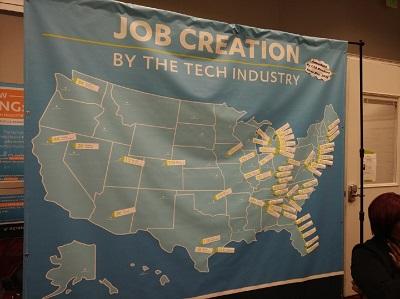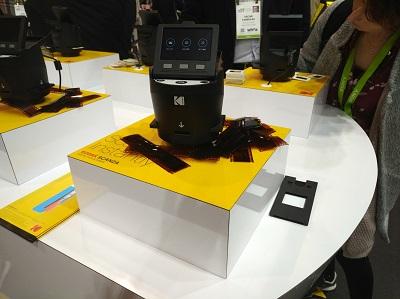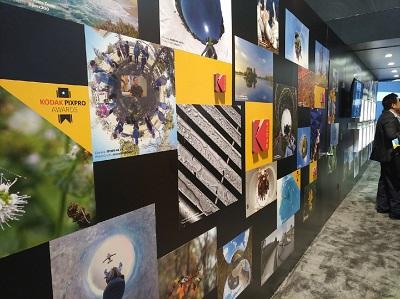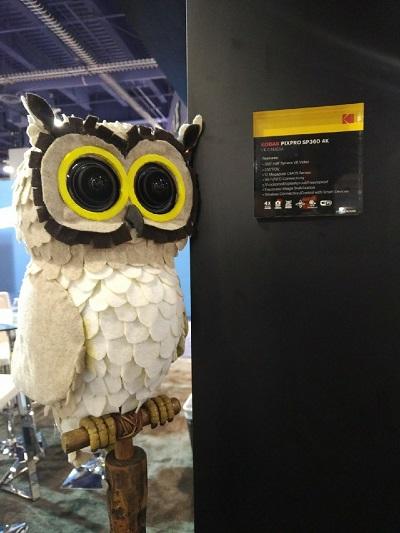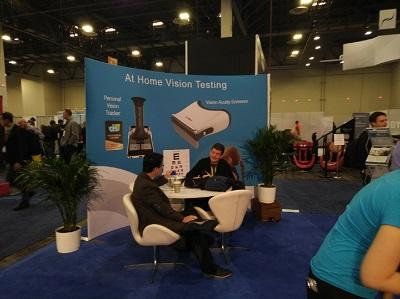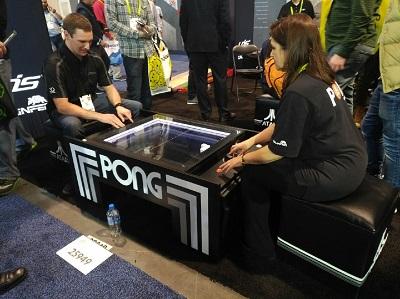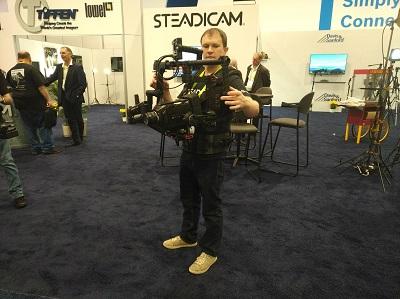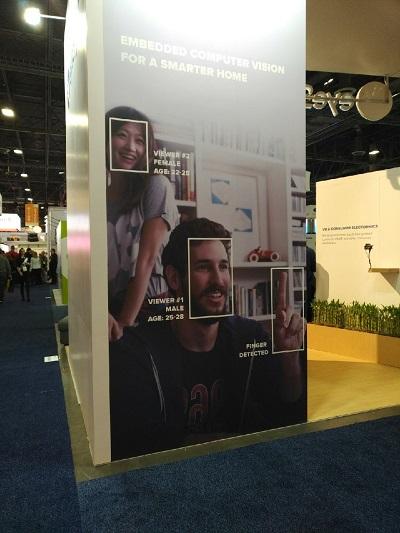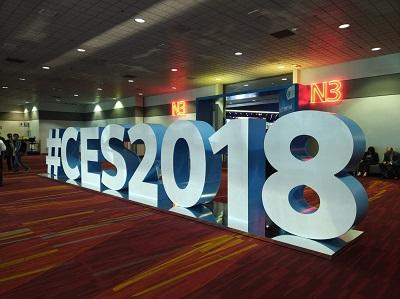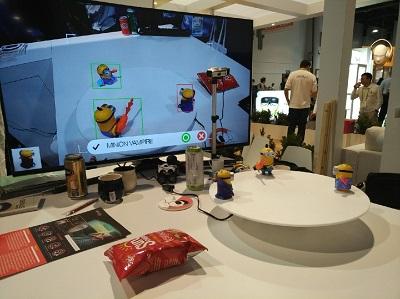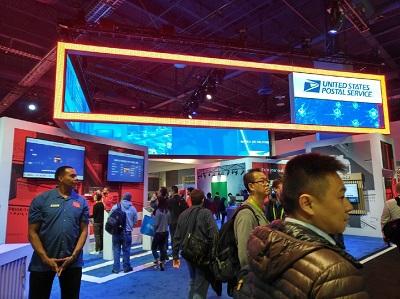By Joshua Seidemann, Vice President of Policy, NTCA
January 24, 2018 – (Las Vegas) I leave CES each year with pages of notes, bundles of business cards, hundreds of pictures, and enough promotional literature to wallpaper my office. I also leave with some impressions that I try to distill to answer a single inquiry: What will make a meaningful difference in rural America?
There is certainly an enormous amount of information flowing out of CES. And, the advancements that are displayed on the show floor span iterative evolutions from existing product segments to remarkable new devices that open a new window.
EyeQue offers two models that measure and track vision acuity. The devices interface with Android and IoS and produce a prescription for eyeglasses that can be ordered from affiliated vendors. The technology does not replace an optometrist who can screen glaucoma and other eye diseases, but it can be useful where access to an optometrist is not available to obtain a current prescription.
But, underlying all of this is that question: Will this make a difference for rural spaces? Without a doubt, telemedicine and elder care applications warrant attention for NTCA members, as many rural areas confront physician shortages and, in some instances, in-migration of retirees. But, I'll use this space to kick off a conversation about education, and the need to prepare young Americans for new jobs.
First, a step back to December. Last month, I participated in a conference that explored the work and role of rural community colleges. These institutions play a critical role for many rural students. They can provide opportunities for job training and bridges to a larger four-year university experience. One conversation at the conference focused on common perceptions of high-school vocational courses. Several people described a stigma that is attached to "shop" or other vocational training. But, these same educators also noted that traditional, so-called "low skill" jobs are disappearing, and that vocational training must now be viewed (and aimed) at supporting "middle skill" jobs (see my post on a related topic here) In sum, the labor force will require a shift to higher skilled workers.
The U.S. Bureau of Labor (BLS) statistics reports 4.1 percent unemployment. BLS statistics also show steadiness, if not incremental growth, in manufacturing jobs. But, those jobs are changing. At a CES session titled, "Preparing America for Jobs of the Future," David Lewis, president and CEO of Operations, Inc., observed that "manufacturing" is an old term. The days of standing on your feet on a line may be diminishing, he explained, but manufacturing is not going away - it is evolving, and the field "needs a rebrand." These types of jobs are now high-tech jobs.
Approximately six million jobs in the United States are open, and many of these are in the tech sector and require middle or high-tech skills. So, there is a gap waiting to be bridged by communities, companies, educational institutions, and policy. Both incoming and existing workers must be provided with opportunities for work-skill development.
A walk through the CES show floor reveals the need. There is no such thing as a "simple fix" anymore. Products that were once entirely mechanical now contain an electronic element. Cars, home appliances, and medical devices are increasingly connected and, accordingly, increasingly complex. Toyota, which commands the third-largest market segment of U.S. auto manufacturing, recognized this evolution.
Hilary Cain, Director, Technology and Innovation Policy, Toyota Motor North America, Inc., explained that as products become more sophisticated, their manufacture becomes more sophisticated. The auto manufacturer has an AI department, and confronts issues that traditionally would have been in the wheelhouse of more "traditional" tech firms such as Amazon or Silicon Valley companies. Recognizing this, Toyota working with community colleges in Kentucky (where 8,000 Toyota employees work alongside robots in production lines) to create an Advanced Manufacturing Degree. This endeavor helps the company find employees with problem solving, communications and technical skills - sorely needed by the manufacturer, but not found among typical graduates of local schools. Toyota worked with a local community college to create the program from the ground up. It includes two-years of course work, eight hours a day, for two days per week, leading to an Associate's Degree in Applied Sciences. For the remaining three days each week, students can work at Toyota for a salary that covers tuition and living expenses. Some students remain in school to complete a four-year degree, and the program has been expanded to nine states in 22 community colleges. Ninety-five percent of students who complete the program find permanent full-time employment with Toyota or another manufacturer.
Walmart, the largest employer in the United States, opened 200 academies at Walmart to train employees for its tech-driven business model. And, Amazon, pursuing expansion of its regional "fulfillment centers," first offered employees 95 percent reimbursement for tuition and books. But, as it found that its best go-getter employees were spending nights and weekends at school, the on-line firm started building classrooms inside its fulfillment centers - with glass walls so that other employees can see and be inspired. And, most importantly, Amazon is taking an "open source" approach to its model, sharing it with other companies, the White House, and state capitols. Stephen Hartell, Director U.S. Public for Policy for Amazon, acknowledged that many people who complete the program eventually leave the company, but averred that Amazon is OK with that.
So, these are the beginnings of an evolution to promote middle-skill jobs. But, more must be done. While states offer tax credits and other benefits for community college and other further education, the next step is to look toward high schools and even middle schools to determine where more technically-oriented coursework can be inserted. This may include coding or other applied sciences, but the ultimate goal is to home-grow our talent.
And, perhaps this is where an opportunity for rural broadband members arises. Summer camps and elementary schools are perfect places to turn students on to tech. NTCA member Endeavor Communications of Cloverdale, Indiana, secured a Foundation for Rural Service grant to support a camp program that enables students to acquire programming and computing skills through robotics operation. Charles Fluharty, president and CEO of the Rural Policy Research Institute, described this type of approach at an NTCA event about two years ago. Dr. Fluharty described an Arkansas initiative to include computer science as a core curriculum in every school as "the best and brightest extraction strategy."
Rural natural resources need not be limited to food, fuel and lumber - rural resources include intellect, thoughtfulness, problem solving and other skills ready to be developed for the next generation of American jobs. Connectivity can bring us there.
| The innovator of the digital camera (but not the groundbreaking market entrant) offered a series of digital imaging devices, including this unit that can convert slides to digital images. | I am always curious to see what Kodak displays. | Perhaps one of the more visually interesting products displayed by Kodak. |
| EyeQue offers two models that measure and track vision acuity. The devices interface with Android and IoS and produce a prescription for eyeglasses that can be ordered from affiliated vendors. The technology does not replace an optometrist who can screen glaucoma and other eye diseases, but it can be useful where access to an optometrist is not available to obtain a current prescription. | It's not connected or broadband enabled, but it was kind of fun. Pong was the world's first video game. This new table version uses magnets and real (as opposed to virtual) blocks and balls. | In the Parthenon of "everything old is . . . " sits the Steadicam. First developed in 1975, it enabled memorable scenes from Rocky, The Shining, and Goodfellas. Although its claim to fame is mechanical isolation of the cameraman's movements, like refrigerators, cars, toothbrushes and athleticwear, there is always room for digital inclusion. |
|
|
|
|
|
|
|
|

